Abstract
We report the functional characterization of site-directed biotin binding-site mutants of recombinant core streptavidin. The mutagenesis studies were aimed at characterizing the contributions of Trp residues known to contact biotin that have been postulated to control the exceptional binding affinity observed in this system. The functional properties of single site-directed mutants replacing Trp residues with Phe or Ala at positions 79, 108, and 120 were investigated by quantitating the EC50 binding parameters of these mutants to biotin and 2-iminobiotin in an ELISA format. The biotin EC50 for all mutants was the same as wild-type streptavidin, demonstrating that their delta Ka values relative to wild type were < 10(6). The conservative W79F and W108F mutants displayed only a 2- to 3-fold increase in EC50 for 2-iminobiotin, corresponding to an estimated delta Ka < 10, while the W120F mutant displayed a much greater alteration in 2-iminobiotin EC50, corresponding to an estimated delta Ka of 10(2). These delta Ka values are likely to reflect similar changes for biotin. The 2-iminobiotin EC50 values for the Ala mutants fell outside the accessible concentration range of the ELISA assay, demonstrating that these mutations lowered the Ka by a factor of 10(4) to 10(6). Direct estimation of biotin Ka values for W79A, W120A, and W120F in an ultrafiltration binding assay yielded Ka values of 4.3 x 10(7) M-1, 8.6 x 10(6) M-1, and > 5 x 10(9) M-1, respectively, in excellent agreement with the ELISA estimates of delta Ka with 2-iminobiotin as a reporter ligand. The results of these preliminary functional studies suggest that these aromatic side chains contribute significantly to the streptavidin-biotin binding free energy.
Full text
PDF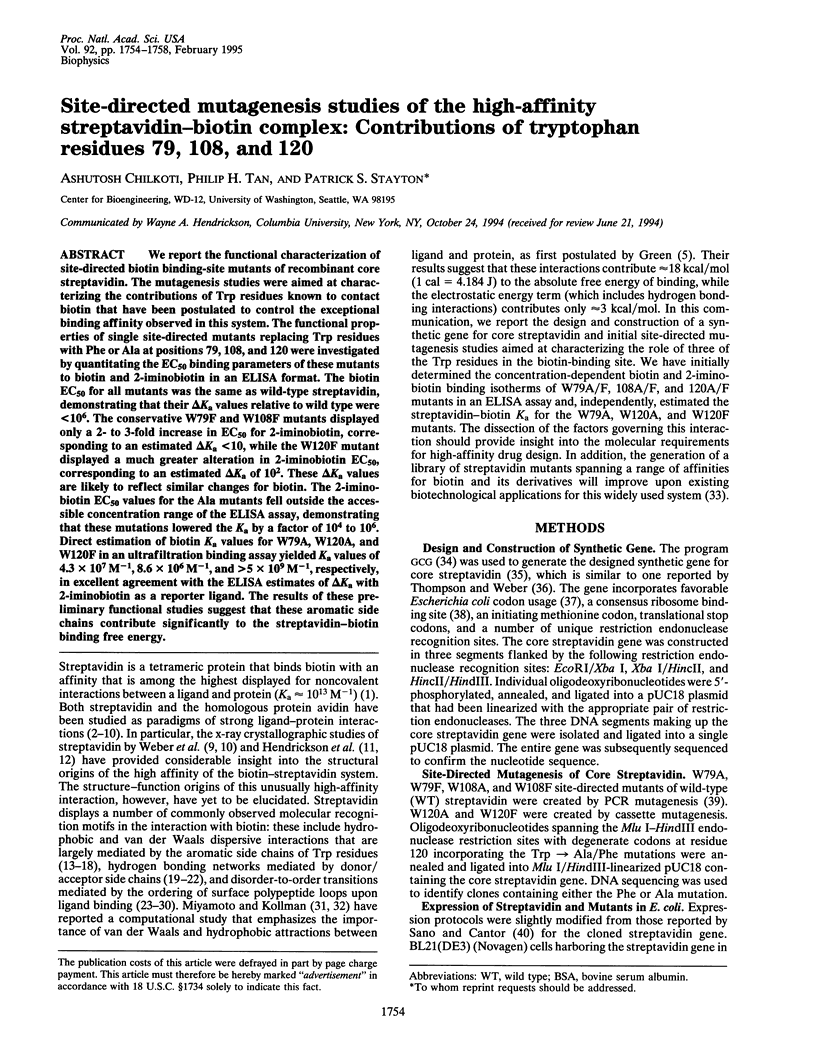
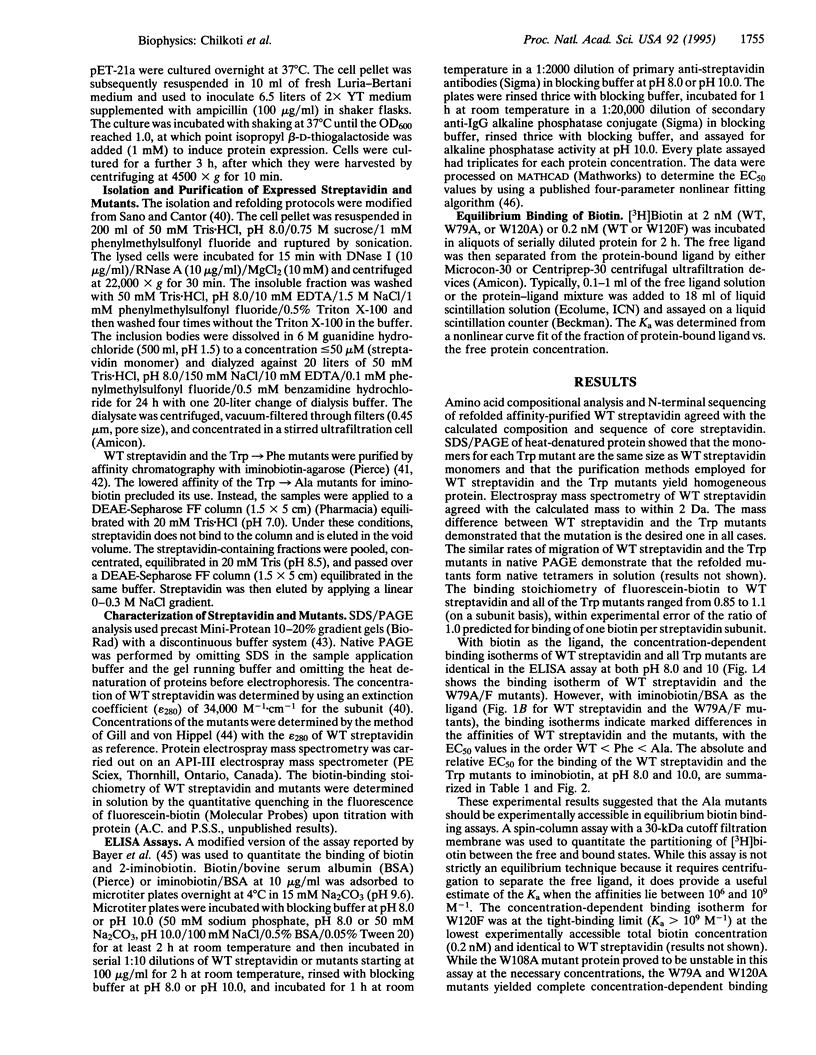
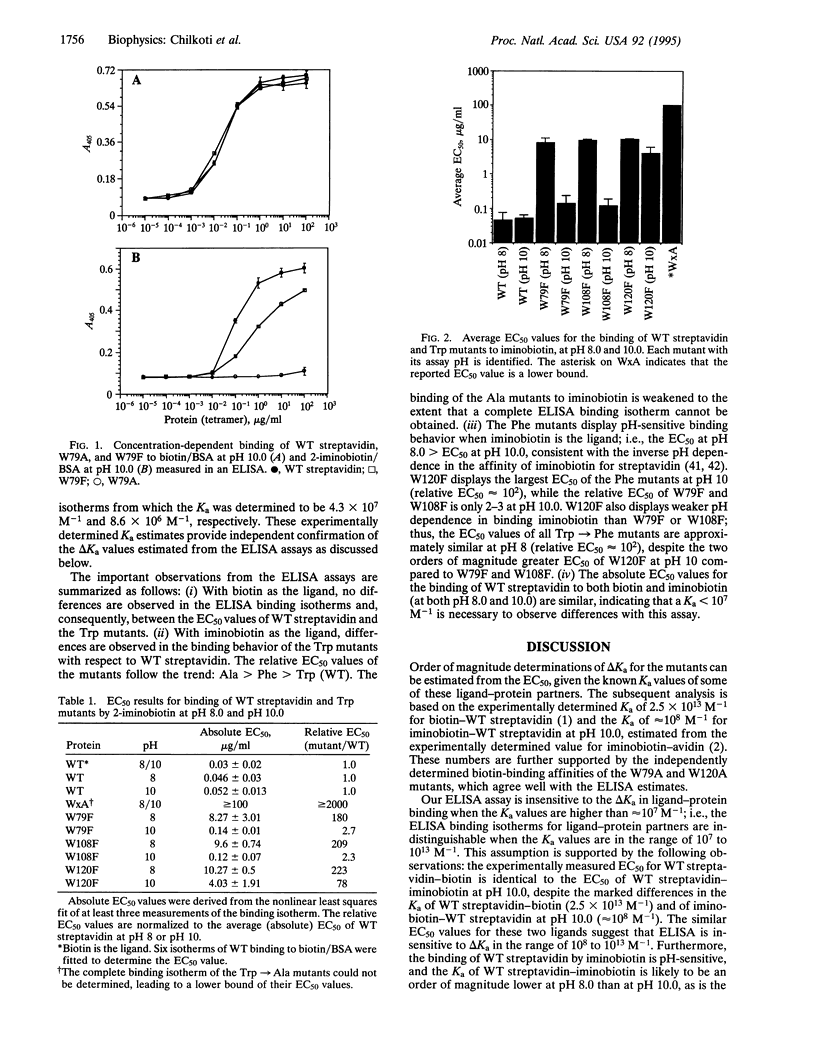
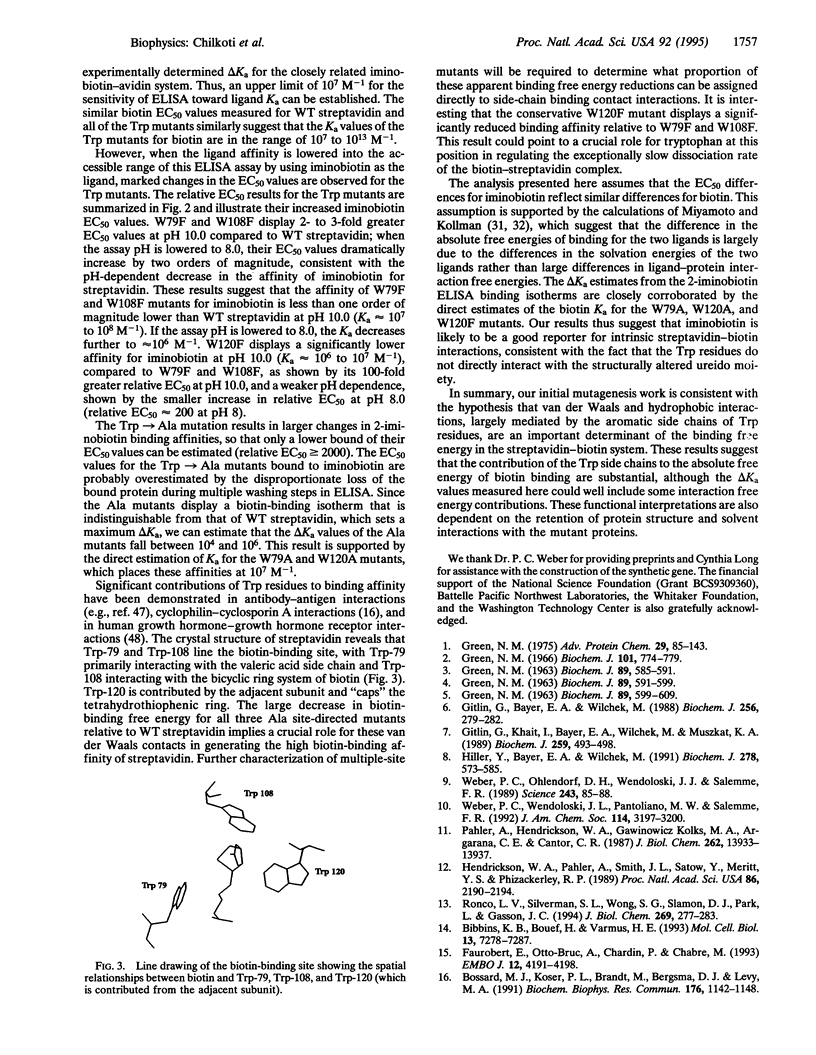
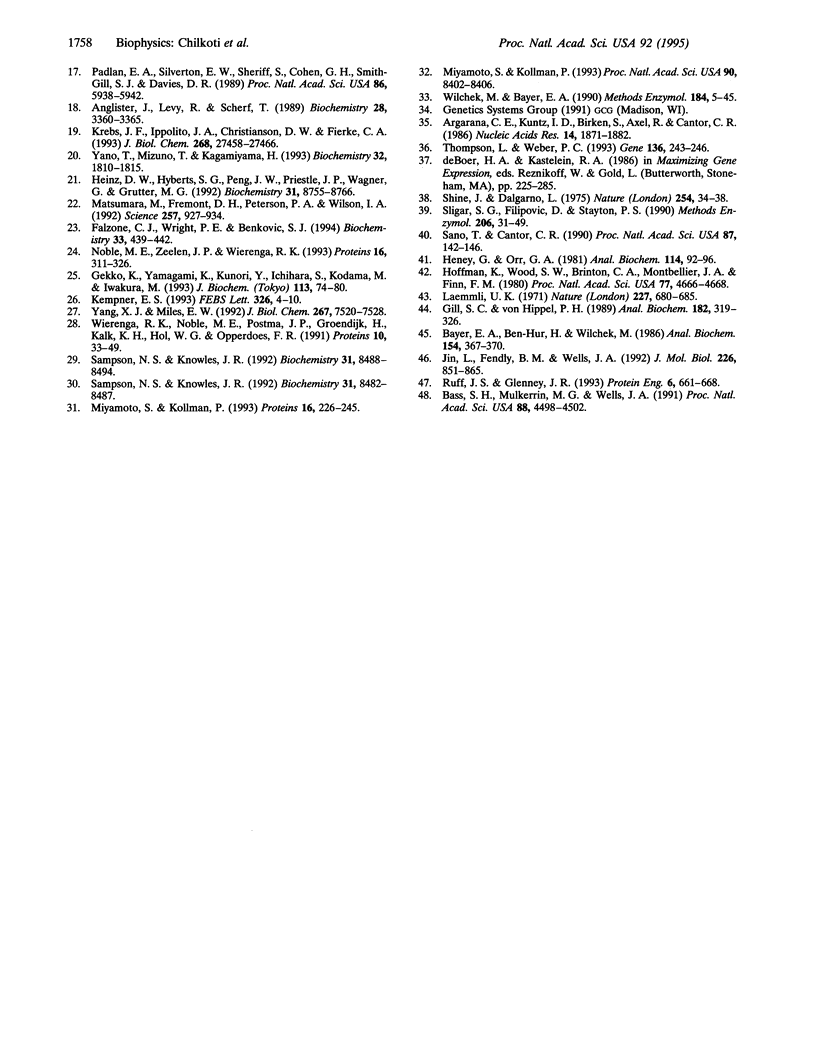
Selected References
These references are in PubMed. This may not be the complete list of references from this article.
- Anglister J., Levy R., Scherf T. Interactions of antibody aromatic residues with a peptide of cholera toxin observed by two-dimensional transferred nuclear Overhauser effect difference spectroscopy. Biochemistry. 1989 Apr 18;28(8):3360–3365. doi: 10.1021/bi00434a035. [DOI] [PubMed] [Google Scholar]
- Argaraña C. E., Kuntz I. D., Birken S., Axel R., Cantor C. R. Molecular cloning and nucleotide sequence of the streptavidin gene. Nucleic Acids Res. 1986 Feb 25;14(4):1871–1882. doi: 10.1093/nar/14.4.1871. [DOI] [PMC free article] [PubMed] [Google Scholar]
- Bass S. H., Mulkerrin M. G., Wells J. A. A systematic mutational analysis of hormone-binding determinants in the human growth hormone receptor. Proc Natl Acad Sci U S A. 1991 May 15;88(10):4498–4502. doi: 10.1073/pnas.88.10.4498. [DOI] [PMC free article] [PubMed] [Google Scholar]
- Bayer E. A., Ben-Hur H., Wilchek M. A sensitive enzyme assay for biotin, avidin, and streptavidin. Anal Biochem. 1986 Apr;154(1):367–370. doi: 10.1016/0003-2697(86)90538-5. [DOI] [PubMed] [Google Scholar]
- Bibbins K. B., Boeuf H., Varmus H. E. Binding of the Src SH2 domain to phosphopeptides is determined by residues in both the SH2 domain and the phosphopeptides. Mol Cell Biol. 1993 Dec;13(12):7278–7287. doi: 10.1128/mcb.13.12.7278. [DOI] [PMC free article] [PubMed] [Google Scholar]
- Bossard M. J., Koser P. L., Brandt M., Bergsma D. J., Levy M. A. A single Trp121 to Ala121 mutation in human cyclophilin alters cyclosporin A affinity and peptidyl-prolyl isomerase activity. Biochem Biophys Res Commun. 1991 May 15;176(3):1142–1148. doi: 10.1016/0006-291x(91)90404-u. [DOI] [PubMed] [Google Scholar]
- Falzone C. J., Wright P. E., Benkovic S. J. Dynamics of a flexible loop in dihydrofolate reductase from Escherichia coli and its implication for catalysis. Biochemistry. 1994 Jan 18;33(2):439–442. doi: 10.1021/bi00168a007. [DOI] [PubMed] [Google Scholar]
- Faurobert E., Otto-Bruc A., Chardin P., Chabre M. Tryptophan W207 in transducin T alpha is the fluorescence sensor of the G protein activation switch and is involved in the effector binding. EMBO J. 1993 Nov;12(11):4191–4198. doi: 10.1002/j.1460-2075.1993.tb06103.x. [DOI] [PMC free article] [PubMed] [Google Scholar]
- GREEN N. M. AVIDIN. 1. THE USE OF (14-C)BIOTIN FOR KINETIC STUDIES AND FOR ASSAY. Biochem J. 1963 Dec;89:585–591. doi: 10.1042/bj0890585. [DOI] [PMC free article] [PubMed] [Google Scholar]
- GREEN N. M. AVIDIN. 3. THE NATURE OF THE BIOTIN-BINDING SITE. Biochem J. 1963 Dec;89:599–609. doi: 10.1042/bj0890599. [DOI] [PMC free article] [PubMed] [Google Scholar]
- Gekko K., Yamagami K., Kunori Y., Ichihara S., Kodama M., Iwakura M. Effects of point mutation in a flexible loop on the stability and enzymatic function of Escherichia coli dihydrofolate reductase. J Biochem. 1993 Jan;113(1):74–80. doi: 10.1093/oxfordjournals.jbchem.a124007. [DOI] [PubMed] [Google Scholar]
- Gill S. C., von Hippel P. H. Calculation of protein extinction coefficients from amino acid sequence data. Anal Biochem. 1989 Nov 1;182(2):319–326. doi: 10.1016/0003-2697(89)90602-7. [DOI] [PubMed] [Google Scholar]
- Gitlin G., Bayer E. A., Wilchek M. Studies on the biotin-binding site of streptavidin. Tryptophan residues involved in the active site. Biochem J. 1988 Nov 15;256(1):279–282. doi: 10.1042/bj2560279. [DOI] [PMC free article] [PubMed] [Google Scholar]
- Gitlin G., Khait I., Bayer E. A., Wilchek M., Muszkat K. A. Studies on the biotin-binding sites of avidin and streptavidin. A chemically induced dynamic nuclear polarization investigation of the status of tyrosine residues. Biochem J. 1989 Apr 15;259(2):493–498. doi: 10.1042/bj2590493. [DOI] [PMC free article] [PubMed] [Google Scholar]
- Green N. M. Avidin. Adv Protein Chem. 1975;29:85–133. doi: 10.1016/s0065-3233(08)60411-8. [DOI] [PubMed] [Google Scholar]
- Green N. M. Thermodynamics of the binding of biotin and some analogues by avidin. Biochem J. 1966 Dec;101(3):774–780. doi: 10.1042/bj1010774. [DOI] [PMC free article] [PubMed] [Google Scholar]
- Heinz D. W., Hyberts S. G., Peng J. W., Priestle J. P., Wagner G., Grütter M. G. Changing the inhibitory specificity and function of the proteinase inhibitor eglin c by site-directed mutagenesis: functional and structural investigation. Biochemistry. 1992 Sep 22;31(37):8755–8766. doi: 10.1021/bi00152a011. [DOI] [PubMed] [Google Scholar]
- Hendrickson W. A., Pähler A., Smith J. L., Satow Y., Merritt E. A., Phizackerley R. P. Crystal structure of core streptavidin determined from multiwavelength anomalous diffraction of synchrotron radiation. Proc Natl Acad Sci U S A. 1989 Apr;86(7):2190–2194. doi: 10.1073/pnas.86.7.2190. [DOI] [PMC free article] [PubMed] [Google Scholar]
- Heney G., Orr G. A. The purification of avidin and its derivatives on 2-iminobiotin-6-aminohexyl-Sepharose 4B. Anal Biochem. 1981 Jun;114(1):92–96. doi: 10.1016/0003-2697(81)90456-5. [DOI] [PubMed] [Google Scholar]
- Hiller Y., Bayer E. A., Wilchek M. Studies on the biotin-binding site of avidin. Minimized fragments that bind biotin. Biochem J. 1991 Sep 1;278(Pt 2):573–585. doi: 10.1042/bj2780573. [DOI] [PMC free article] [PubMed] [Google Scholar]
- Hofmann K., Wood S. W., Brinton C. C., Montibeller J. A., Finn F. M. Iminobiotin affinity columns and their application to retrieval of streptavidin. Proc Natl Acad Sci U S A. 1980 Aug;77(8):4666–4668. doi: 10.1073/pnas.77.8.4666. [DOI] [PMC free article] [PubMed] [Google Scholar]
- Jin L., Fendly B. M., Wells J. A. High resolution functional analysis of antibody-antigen interactions. J Mol Biol. 1992 Aug 5;226(3):851–865. doi: 10.1016/0022-2836(92)90636-x. [DOI] [PubMed] [Google Scholar]
- Kempner E. S. Movable lobes and flexible loops in proteins. Structural deformations that control biochemical activity. FEBS Lett. 1993 Jul 12;326(1-3):4–10. doi: 10.1016/0014-5793(93)81749-p. [DOI] [PubMed] [Google Scholar]
- Krebs J. F., Ippolito J. A., Christianson D. W., Fierke C. A. Structural and functional importance of a conserved hydrogen bond network in human carbonic anhydrase II. J Biol Chem. 1993 Dec 25;268(36):27458–27466. [PubMed] [Google Scholar]
- Laemmli U. K. Cleavage of structural proteins during the assembly of the head of bacteriophage T4. Nature. 1970 Aug 15;227(5259):680–685. doi: 10.1038/227680a0. [DOI] [PubMed] [Google Scholar]
- MELAMED M. D., GREEN N. M. AVIDIN. 2. PURIFICATION AND COMPOSITION. Biochem J. 1963 Dec;89:591–599. doi: 10.1042/bj0890591. [DOI] [PMC free article] [PubMed] [Google Scholar]
- Matsumura M., Fremont D. H., Peterson P. A., Wilson I. A. Emerging principles for the recognition of peptide antigens by MHC class I molecules. Science. 1992 Aug 14;257(5072):927–934. doi: 10.1126/science.1323878. [DOI] [PubMed] [Google Scholar]
- Miyamoto S., Kollman P. A. Absolute and relative binding free energy calculations of the interaction of biotin and its analogs with streptavidin using molecular dynamics/free energy perturbation approaches. Proteins. 1993 Jul;16(3):226–245. doi: 10.1002/prot.340160303. [DOI] [PubMed] [Google Scholar]
- Miyamoto S., Kollman P. A. What determines the strength of noncovalent association of ligands to proteins in aqueous solution? Proc Natl Acad Sci U S A. 1993 Sep 15;90(18):8402–8406. doi: 10.1073/pnas.90.18.8402. [DOI] [PMC free article] [PubMed] [Google Scholar]
- Noble M. E., Zeelen J. P., Wierenga R. K. Structures of the "open" and "closed" state of trypanosomal triosephosphate isomerase, as observed in a new crystal form: implications for the reaction mechanism. Proteins. 1993 Aug;16(4):311–326. doi: 10.1002/prot.340160402. [DOI] [PubMed] [Google Scholar]
- Padlan E. A., Silverton E. W., Sheriff S., Cohen G. H., Smith-Gill S. J., Davies D. R. Structure of an antibody-antigen complex: crystal structure of the HyHEL-10 Fab-lysozyme complex. Proc Natl Acad Sci U S A. 1989 Aug;86(15):5938–5942. doi: 10.1073/pnas.86.15.5938. [DOI] [PMC free article] [PubMed] [Google Scholar]
- Pähler A., Hendrickson W. A., Kolks M. A., Argaraña C. E., Cantor C. R. Characterization and crystallization of core streptavidin. J Biol Chem. 1987 Oct 15;262(29):13933–13937. [PubMed] [Google Scholar]
- Ronco L. V., Silverman S. L., Wong S. G., Slamon D. J., Park L. S., Gasson J. C. Identification of conserved amino acids in the human granulocyte-macrophage colony-stimulating factor receptor alpha subunit critical for function. Evidence for formation of a heterodimeric receptor complex prior to ligand binding. J Biol Chem. 1994 Jan 7;269(1):277–283. [PubMed] [Google Scholar]
- Ruff-Jamison S., Glenney J. R., Jr Molecular modeling and site-directed mutagenesis of an anti-phosphotyrosine antibody predicts the combining site and allows the detection of higher affinity interactions. Protein Eng. 1993 Aug;6(6):661–668. doi: 10.1093/protein/6.6.661. [DOI] [PubMed] [Google Scholar]
- Sampson N. S., Knowles J. R. Segmental motion in catalysis: investigation of a hydrogen bond critical for loop closure in the reaction of triosephosphate isomerase. Biochemistry. 1992 Sep 15;31(36):8488–8494. doi: 10.1021/bi00151a015. [DOI] [PubMed] [Google Scholar]
- Sampson N. S., Knowles J. R. Segmental movement: definition of the structural requirements for loop closure in catalysis by triosephosphate isomerase. Biochemistry. 1992 Sep 15;31(36):8482–8487. doi: 10.1021/bi00151a014. [DOI] [PubMed] [Google Scholar]
- Sano T., Cantor C. R. Expression of a cloned streptavidin gene in Escherichia coli. Proc Natl Acad Sci U S A. 1990 Jan;87(1):142–146. doi: 10.1073/pnas.87.1.142. [DOI] [PMC free article] [PubMed] [Google Scholar]
- Shine J., Dalgarno L. Determinant of cistron specificity in bacterial ribosomes. Nature. 1975 Mar 6;254(5495):34–38. doi: 10.1038/254034a0. [DOI] [PubMed] [Google Scholar]
- Sligar S. G., Filipovic D., Stayton P. S. Mutagenesis of cytochromes P450cam and b5. Methods Enzymol. 1991;206:31–49. doi: 10.1016/0076-6879(91)06074-d. [DOI] [PubMed] [Google Scholar]
- Thompson L. D., Weber P. C. Construction and expression of a synthetic streptavidin-encoding gene in Escherichia coli. Gene. 1993 Dec 22;136(1-2):243–246. doi: 10.1016/0378-1119(93)90472-f. [DOI] [PubMed] [Google Scholar]
- Weber P. C., Ohlendorf D. H., Wendoloski J. J., Salemme F. R. Structural origins of high-affinity biotin binding to streptavidin. Science. 1989 Jan 6;243(4887):85–88. doi: 10.1126/science.2911722. [DOI] [PubMed] [Google Scholar]
- Wierenga R. K., Noble M. E., Postma J. P., Groendijk H., Kalk K. H., Hol W. G., Opperdoes F. R. The crystal structure of the "open" and the "closed" conformation of the flexible loop of trypanosomal triosephosphate isomerase. Proteins. 1991;10(1):33–49. doi: 10.1002/prot.340100105. [DOI] [PubMed] [Google Scholar]
- Yang X. J., Miles E. W. Threonine 183 and adjacent flexible loop residues in the tryptophan synthase alpha subunit have critical roles in modulating the enzymatic activities of the beta subunit in the alpha 2 beta 2 complex. J Biol Chem. 1992 Apr 15;267(11):7520–7528. [PubMed] [Google Scholar]
- Yano T., Mizuno T., Kagamiyama H. A hydrogen-bonding network modulating enzyme function: asparagine-194 and tyrosine-225 of Escherichia coli aspartate aminotransferase. Biochemistry. 1993 Feb 23;32(7):1810–1815. doi: 10.1021/bi00058a015. [DOI] [PubMed] [Google Scholar]


